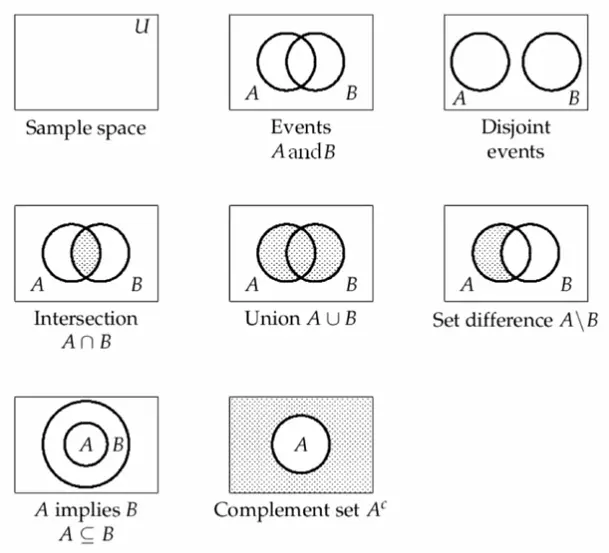Prerequisites: logic
Set
A set is a collection of distinct objects, considered as an object in its own right. Sets are usually denoted by capital letters, e.g. .
The objects in a set are called the elements or members of the set. We write if is an element of the set , and if is not an element of .
denotes the empty set, which contains no elements.
B means that every element of is also an element of .
Link to originalCardinality
The cardinality of a set is the number of elements in .
We denote the cardinality of by , also denoted by or .
Sub- and supersets
A set is a subset of a set , denoted by , if every element of is also an element of :
is then called a superset of .
If we consider for a fixed , we call the underlying or universal set.
If is a subset of but , we write or and say that is a proper subset of .
The empty set is a subset of every set.
Two sets and are equal if and only if both are subsets of each other.
Ways of denoting sets.
Roster notation: or listing elements (“aufzählend”)
Set builder notation: , where is a property that must satisfy (“beschreibend”), e.g.:
Subsets: e.g.: (more common)
Interval notation:
Union (Vereinigung)
The union of two sets and , denoted by , is the set of all elements that are in or in or in both:
Or for set systems (more than two sets):
is the index set (the set of indices for the sets which we are taking the union of).
Intersection ((Durch)Schnitt)
The intersection of two sets and , denoted by , is the set of all elements that are in both and :
Or for set systems (more than two sets):
Complement
Let’s call the set of all elements we are working with (Grundmenge / basic set). Then we can define the complement of a set as the set of all elements in that are not in :
Other notations for the complement:
Difference
The difference of two sets and , denoted by , is the set of all elements that are in but not in :
Symmetric difference
The symmetric difference of two sets and , denoted by , is the set of all elements that are in exactly one of the two sets (like an xor):
(NOTE: Due to a bug in Obsidian-tikzjax, the symmetric difference only renders correctly in live-preview mode… click the link for correct rendering)

Properties of sets
Element-set addition (Minkowski sum with singleton)
For an element and a set , the notation means applying element-wise:
This is a special case of the Minkowski sum.
In group theory, this is called a coset.
Proving set identities
“Rückführung auf logische Regeln” (reduction to logical rules):
“Anwenden der Äquivalenz” (applying the equivalence):
Element table: Create a table with and for each set, then compare the tables, just like a truth table in logic.
cartesian product
Link to originalCartesian product
The cartesian product of two sets and , denoted by , is the set of all possible ordered pairss where and :
e.g.: and , thenThe cartesian product is not commutative:
Taking the cartesian product of mutiple sets:
The cardinality of the cartesian product is the product of the cardinalities of the individual sets:
So the cartesian product of a set with the empty set is the empty set:
Link to originalIntervals and set operations
Further reading:
power set
relation
bounded set
multiset
^functions-as-sets
…
A note on terminology
https://mathworld.wolfram.com/Collection.html says that a collection refers to a multiset.
But gpt5 says that’s almost certainly not the case in most contexts, a collection just a set.
But collection is so generic and context dependent, I only use it as “a bunch of things” and then define if necessary, else use a more specific term.